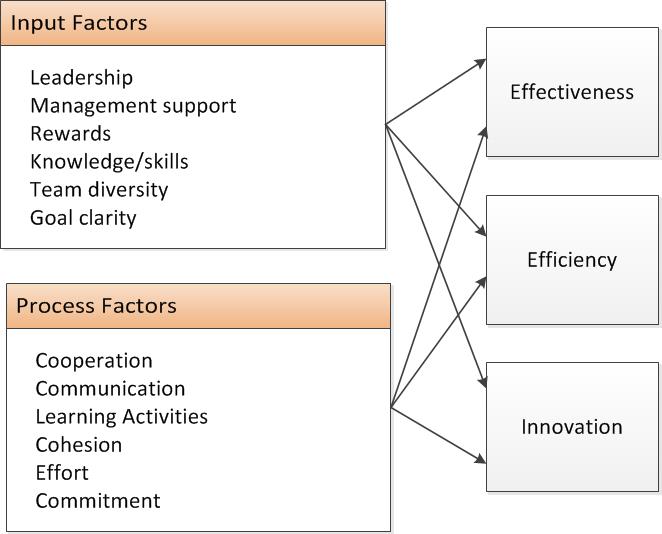With much of the work in organizations accomplished through teams it is important to determine the factors that lead to effective as well as ineffective team processes and to better specify how, why, and when they contribute. It doesn’t matter if the team is brought together for a specific project and then disbands, or if it is a fairly permanent part of the organization, similar principles are at work.

The input-process-output model of teams is a great place to start. While simplistic, it can offer a good model of what makes teams works and is applicable to the different types of teams.
Input factors are the organizational context, team composition, task design that influence the team. Process factors are what mediates between the inputs and desired outputs.
- Leadership: The leadership style(s) (participative, facilitative, transformational, directive, etc) of the team leader influences the team toward the achievement of goals.
- Management support refers to the help or effort provided by senior management to assist the project team, including managerial involvement and resource support.
- Rewards are the recompense that the organization gives in return for good work.
- Knowledge/skills are the knowledge, experience and capability of team members to process, interpret, manipulate and use information.
- Team diversity includes functional diversity as well as overall diversity.
- Goal clarity is the degree to which the goals of the project are well defined and the importance of the goals to the organization is clearly communicated to all team members.
- Cooperation is the measure of how well team members work with each other and with other groups.
- Communication is the exchange of knowledge and information related to tasks with the team (internal) or between team members and external stakeholders (external).
- Learning activities are the process by which a team takes action, contains feedback and makes changes to improve. Under this fits the PDCA lifecycle, including Lean, SixSigma and similar problem solving methodologies..
- Cohesion is the spirit of togetherness and support for other team members that helps team members quickly resolve conflicts without residual hard feelings, also referred to as team trust, team spirit, team member support or team member involvement.
- Effort includes the amount of time that team members devote to the project.
- Commitment refers to the condition where team members are bound emotionally or intellectually to the project and to each other during the team process.
Process Factors are usually the focus on team excellence frameworks, such as the ASQ or the PMI.
Outputs, or outcomes, are the consequences of the team’s actions or activities:
- Effectiveness is the extent a project achieves the performance expectations of key project stakeholders. Expectations are usually different for different projects and across different stake-holders; thus, various measures have been used to evaluate effectiveness, usually quality, functionality, or reliability. Effectiveness can be meeting customer/user requirements, meeting project goals or some other related set of measures.
- Efficiency is the ability of the project team to meet its budget and schedule goals and utilize resources within constraints Measures include: adherence to budget, adherence to schedule, resource utilization within constraints, etc.
- Innovation is the creative accomplishment of teams in generating new ideas, methods, approaches, inventions, or applications and the degree to which the project outputs were novel.
Under this model we can find a various levers to improve out outcomes and enhance the culture of our teams.

16 thoughts on “Team Effectiveness”